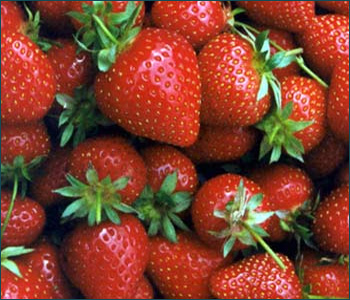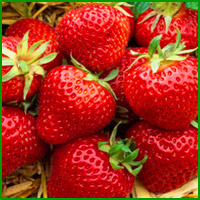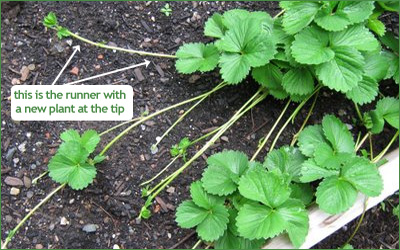Growing Strawberries in Your New England Garden - a Fun Project for the Whole Family
Last Updated:
If you've never had fresh strawberries from the garden, you are definitely missing out! Home grown strawberries are one of the most delicious things gardeners can grow in their gardens, and they can do it with little to no care.

Plant Your Strawberries in early to mid Spring for a Crop This June
Strawberries are best purchased as small plants from either the internet or a local garden center. They are generally sold in packs of about 10. For a family of four, we suggest planting about 20-30 plants to have enough for cereal and dessert toppings! Be aware there are two main types, traditional and everbearing. Get the traditional types and you will have better strawberries - the everbearing varieties will produce berries all season up until fall, however the big crop of the year will still be in mid to late June. Most people these days prefer the everbearing varieties so they can extend their harvest past June when traditional varieties will stop producing for the year.
What Variety of Strawberry You Plant Does Matter
There are hundreds, if not thousands of varieties out there to choose from, but they are bred for different climates and fruiting times. Here in New England, there is one standout winner amongst the rest. It's called the Seascape Strawberry, and it's been bred for conditions like we have here in New England. The bonus- it's an everbearing variety meaning you'll get strawberry crops at least twice during the season! Another great choice is Albion- it's been bred for disease resistance and they are one of the sweetest varieties. We recommend buying them here.
Seascape Strawberries

- bred for coastal climates
- bears fruit all season
- large fruit, resistant to disease
 DISCLAIMER: We may earn commissions on products sold through Amazon
DISCLAIMER: We may earn commissions on products sold through Amazon
Albion Strawberries

- bred for disease resistance
- bears fruit all season
- large fruit, incredibly sweet
 DISCLAIMER: We may earn commissions on products sold through Amazon
DISCLAIMER: We may earn commissions on products sold through Amazon
NOTE: Strawberries love the sunshine, so plant them (as with most other fruits and vegetables) in a place that gets a minimum of 6-8 hours of sun a day. They are fairly drought-tolerant once established, but its a good idea to keep them watered for the first month or so until their roots take hold in the soil.
The Strawberry's Biggest Enemy is Mold
Plant your strawberries about 6 inches apart in rows, burying them so that the new growth, if any, is showing above the soil. It is really important to mulch around them, preferably with straw. This keeps the berries from touching the ground and rotting - strawberries from home gardens are MUCH softer and sweeter than those in the grocery stores and can bruise and mold very easily. This also means you should avoid watering the plants in the late afternoon or evening hours, which could encourage mold to develop overnight.
Pick Your Strawberries Daily Once They Start to Ripen
Strawberries can go from whitish green to red in just a couple of warm days so make sure you check your strawberry patch at least every other day. You should get about a 2 to 3 week supply of fresh berries lasting until about the first week in July. After that, just manage the runners to stay within the confines of your rows and leave the rest to mother nature. If you have an everbearing variety like Seascape, they will continue to produce berries all season, but the crop won't be as large as the first crop in June.
Strawberries Are Perennials - They Come Up Year After Year
Despite this fact, its important to note that over time, strawberry plants lose their punch and after a few years, will stop bearing fruit and eventually die off. The good news is that strawberries send out what are called "runners" from their plants. These are essentially long flexible stems with little strawberry plants at the end. These "runners" will extend out from the main plant, putting down roots about a foot away from the plant. This process will start a new plant and replace the original older plant once it stops fruiting. Sometimes these runners can have 2 or 3 plants on them, all about a foot apart. If you train them properly along the strawberry row rather than letting them run wild through the garden, they will increase your supply of strawberry plants and ensure a steady supply of strawberries for many years to come.

Strawberries and Winter Protection
If you live in an extremely cold area during the winter, just cover the strawberry plants with the straw or mulch for extra protection. Don't worry, next spring you'll see them pop right through the mulch, ready to supply you and your family with another season of delicious berries. More importantly, the straw will help the next year's crop from resting on the soil and rotting. Good for you, good for them!
Freezing Fresh Strawberries
Just because the strawberry season is short doesn't mean we can't put them away for a rainy day. How nice it is to open a container of your strawberries in the middle of winter and dig in! The process for freezing them is simple: just place them on a sheet tray individually (not touching) and place the tray in the freezer. Once frozen, transfer to containers or bags for storage. Freezing them separately does 2 things: it encourages faster freezing and also prevents you from dealing with a frozen lump when you go to defrost them later. Freezing them quickly also reduces the amount of freezer damage to the berries, helping them to keep their shape more when you go to enjoy them later on.
Seascape Strawberries

- bred for coastal climates
- bears fruit all season
- large fruit, resistant to disease
 DISCLAIMER: We may earn commissions on products sold through Amazon
DISCLAIMER: We may earn commissions on products sold through Amazon
Albion Strawberries

- bred for disease resistance
- bears fruit all season
- large fruit, incredibly sweet
 DISCLAIMER: We may earn commissions on products sold through Amazon
DISCLAIMER: We may earn commissions on products sold through Amazon
Please Note: As an Amazon Associate we earn from qualifying purchases